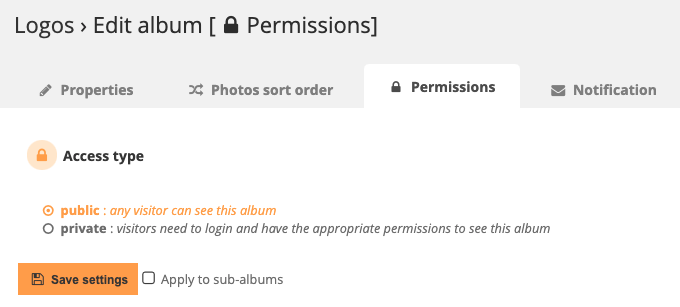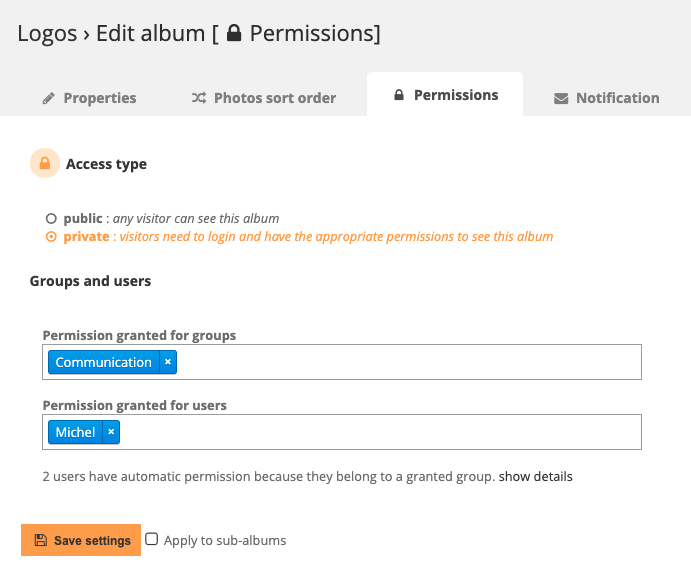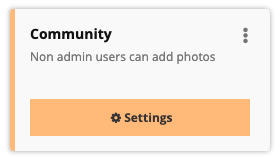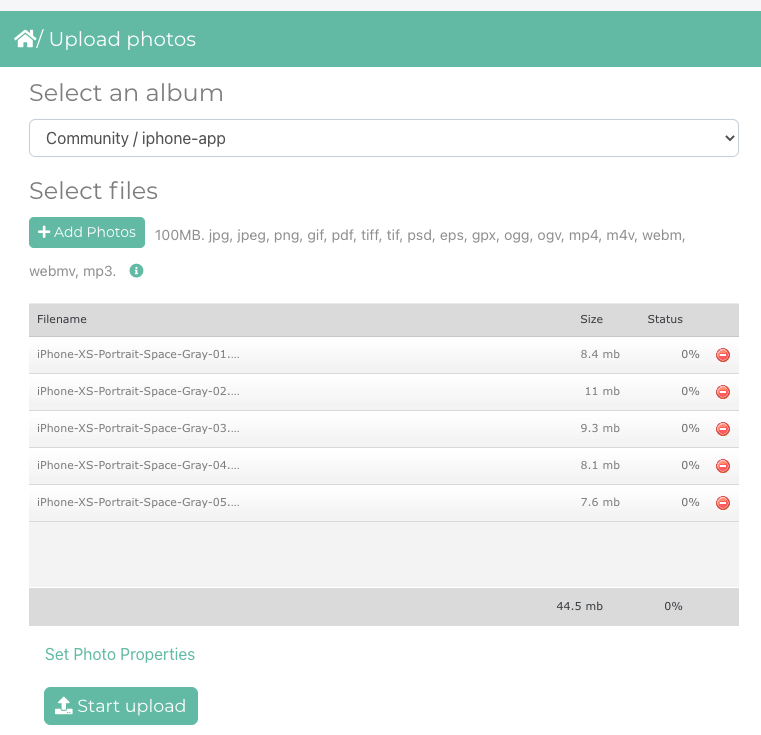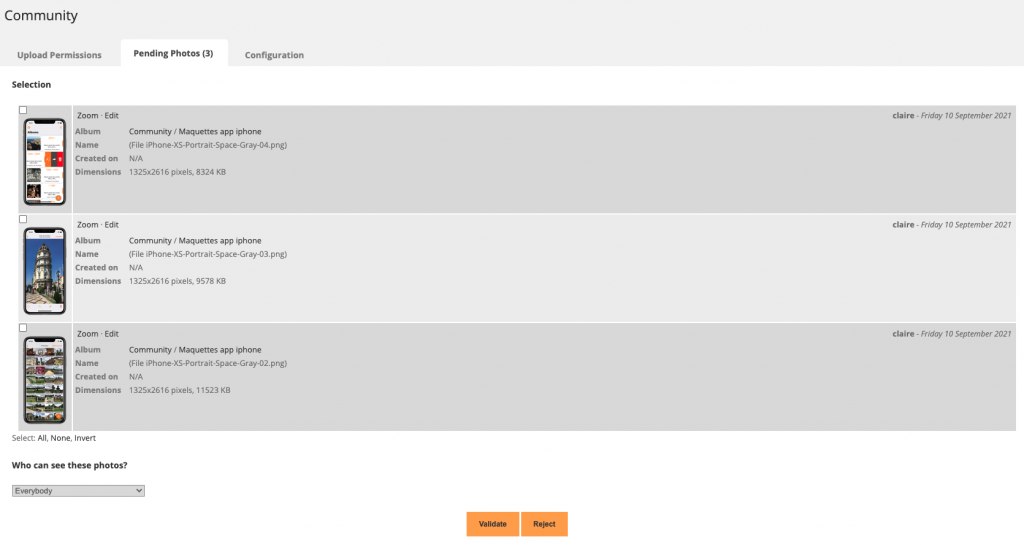How to organize team work with Piwigo?

Over the years, Piwigo has integrated many features that allow you to collaborate with your team or partners, in an efficient and secure way. However, some of these features are still unknown to our customers! That’s why we have decided to focus on user management in this article.
Table of contents
- The guide of user statuses and permissions in Piwigo
- The most common user statuses
- Administrator
- User
- Other user statuses in Piwigo
- User permissions in Piwigo: who sees what?
- Access by album
- Private and public albums
- Permissions by album
- Access by privacy level
- Who can add photos to your Piwigo photo library?
The guide of user statuses and permissions in Piwigo
Piwigo proposes very fine user management, as you probably already know.
We thought it would be interesting to review how the different statuses and permissions work.
The most common user statuses
Administrator
Administrators have access to all the data in Piwigo, and most importantly, to the administration area:
- add, modify and delete albums,
- add, modify and delete photos,
- add, modify and delete users,
- tag management,
- view statistics and history of actions in the gallery,
- comment management.
However, they do not have access to setting the gallery theme, nor to adding plugins.
User
Users can log in to your Piwigo gallery, but not to the administration area.
By default, when you create an account in Piwigo, a person has the status of User.
Users can view and download files in your photo library, but they cannot add photos to Piwigo (except with the Community plugin, we will look at this a bit further).
Other user statuses in Piwigo
- Webmaster : they have the same rights as the Administrators, but also other rights: enable or disable plugins, modify the theme, access the gallery configuration options… By default, the first user created during registration is Webmaster.
- Generic : This status can be useful when several people share the same user account. Generic users have access to your gallery but not to the administration, just like classic Users, but with some specificities (they can not change the password or the display language, for example).
- Guest : This status is for users who have been deactivated (e.g. former users who have left your team).
User permissions in Piwigo: who sees what?
As we have just seen, in Piwigo, there are different statuses, or user profiles.
But it doesn’t say how you can choose who can access which files, which albums… This is an important concern when several teams or departments share access to the photo library.
For this, there are two different levels of access management: by album, and by privacy level.
Access by album
The easiest and most common way is to manage access by album.
Private and public albums
First of all, you can define for each album its status: private or public.
Public albums will be visible to all offline visitors of your photo library. As soon as someone visits your gallery’s website on the internet, they can view the public albums.
Private albums are only accessible to identified users who have logged in with their login and password. By the way, you can choose to set up all your albums private: in this case, no one can access your photo library without logging in to your Piwigo. This is very common in organizations and companies.
Permissions by album
Then, for each private album, we can set up, among users, who has the right to view it.
To make the management of these permissions easier, you should create groups of users (by department, for example), and manage permissions by group.
This way, as soon as you create an album, you decide which user groups have access to it, and this authorization is automatically reflected on all users of the group.
Access by privacy level
But if you need to manage very specific permissions on a file-by-file basis, independent of albums, you can look into this feature.
In Piwigo, each file can be associated with a privacy level.
By default, here are the privacy levels present in Piwigo (but you can rename them by customizing the labels in each language):
- Admins
- Family
- Friends
- Contacts
- None (by default)
Each user will also need to be assigned a privacy level. Users with the highest level (Admins) will have access to everything.
“Family” users will only have access to photos associated with the “Family”, “Friends” and “Contacts” privacy levels.
“Friends” users will only have access to the “Friends” and “Contacts” levels.
“Contacts” users will only see files in the “Contacts” level.
It is a “cascading” rights management, a bit complex to understand and not very flexible, that’s why we do not advise beginners to use it.
Who can add photos to your Piwigo photo library?
As we saw in the first chapter of this article, only administrators are allowed to add files to Piwigo.
“Regular” users, who only have access to the web gallery and not to the administration area, can’t add files to Piwigo, and that’s normal: if everyone could do it, it would be a mess.
However, it is sometimes necessary, for several reasons:
- You work with a photographer, and to save time, you want him to send his latest photo shoot directly to Piwigo, rather than burning files onto a CD or sending a file transfer link;
- Some of your team members are in charge of creating files (editing photos, graphics, brochures…) and they need to upload files on an album without asking to an administrator;
- Users in the field need to send pictures taken on site (maintenance workers, site managers, sales representatives…). Allowing them to add them directly to Piwigo saves time for everyone (especially if they use the Piwigo mobile application for iOS or Android!).
Well, it’s possible with the Community plugin!
Once this plugin is activated, you will be able to choose:
- Who has the right to add photos on Piwigo (everyone, specific users, members of one or more groups…);
- In which album(s) they have the right to add files. It is possible to create a specific album for each user, if the files need to be reviewed by an administrator before final classification in the photo library;
- If the photos need to be validated by an administrator before they are published in the gallery.
Visitors logged in to your gallery and authorized to add photos will have access to a new “Add photos” page that contains an upload form.
In most cases, files uploaded by users must be validated by an administrator before being added to the library. In this case, the administrator is notified by email that new photos have been added.
They can then, for each added file, validate or reject it. They can also edit the files (properties, title, tags…), and their confidentiality level.
So, is it clear to you now?
If you’ve read this article, as an administrator of your gallery, you might consider reviewing your Piwigo users and their permissions. Maybe it’s time to clean up a bit!
And if you didn’t know the Community plugin, there is a good chance that you will find it useful!
We’ll meet again soon for a new article, to review the collaborative features and especially the sharing options in Piwigo.

